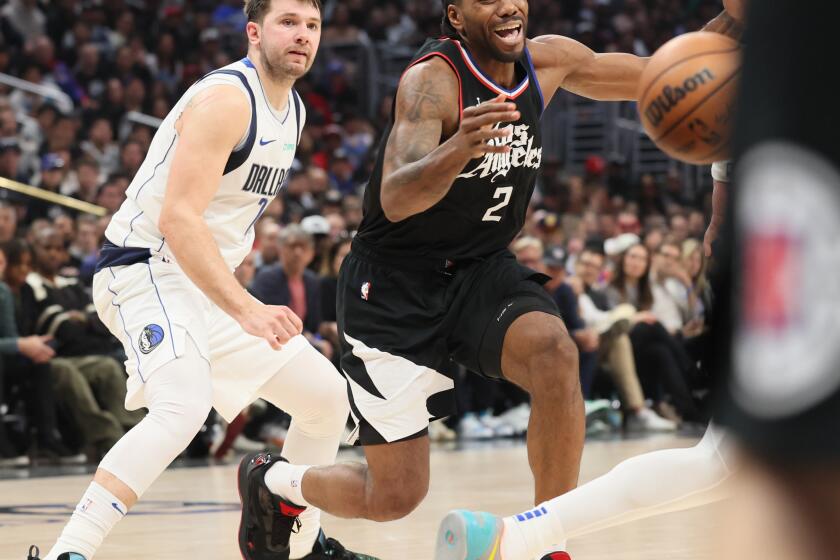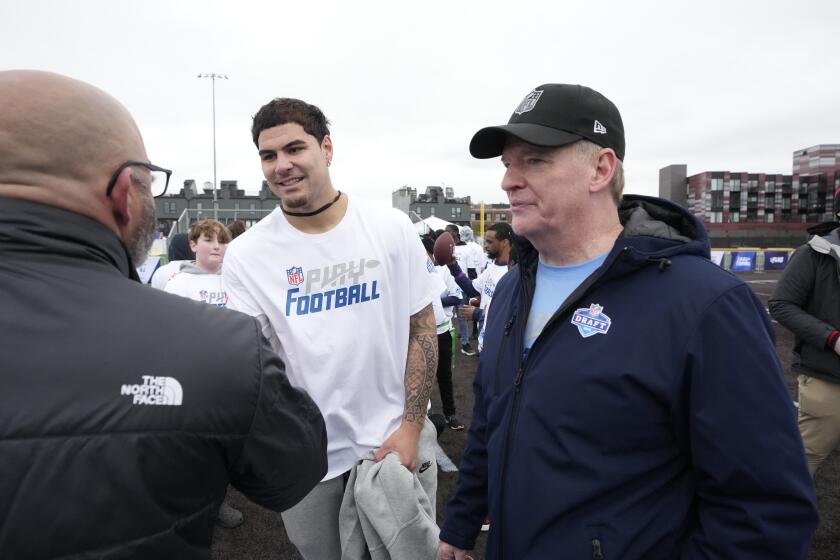As testing gets better, dopers get more clever
As it tries to rid itself of steroids, Major League Baseball is almost certain to strike out. The reason: Athletes who use performance-enhancing drugs have science on their side, experts said Friday.
Chemists are continually refining their recipes to stay at least one step ahead of any testing regimen.
“I could figure out how to take a fair amount of testosterone and you’d never catch me, and if I can say that, a lot of others can too,” said Don H. Catlin, founder of the Anti-Doping Research Institute in West Los Angeles and former director of UCLA’s Olympic drug-testing lab.
“The people who are doing the testing are getting better and the dopers are getting more and more clever,” said Catlin, who has a $500,000 grant from Major League Baseball to develop a test for human growth hormone. “Every time we think we got it under control and have it whacked, there is already something else out there they are using.”
The race between baseball and dopers is made more lopsided by the fact that the amount of drugs that athletes use can be minuscule -- far less than the amount testers require to detect it.
“Small doses work,” said Charles Yesalis, a retired professor of health and human development at Penn State University. “A 1% to 2% increase in performance is unbelievably valuable to an elite athlete, and very often we can’t even measure that as statistically significant in the laboratory.”
Athletes have been doping at least since American Thomas Hicks won the 1904 Olympic marathon in St. Louis with the help of brandy and strychnine, a stimulant, administered by associates during the race.
Anabolic steroids help the body produce muscle and other tissues. Chemists isolated them in the early 1930s and made synthetic versions soon afterward. It didn’t take long for scientists to adapt them for use in weightlifting and other athletic competitions to boost strength.
Major League Baseball banned steroids in 1991, though testing didn’t begin until 2003. Players adapted by switching to other banned substances, said Dr. Gary Wadler, the incoming chairman of the prohibited list and methods committee of the World Anti-Doping Agency.
“As we’ve gotten better at our detection of anabolic steroids, there was a shift to human growth hormone because there was not testing being done for it,” said Wadler, who is also a clinical associate professor of medicine at New York University School of Medicine.
Human growth hormone is a natural substance that fuels growth during childhood and helps maintain tissues and organs in adulthood. It is also sold as a prescription drug for short children whose bodies don’t produce enough of it on their own. It also is used to treat the wasting associated with AIDS.
Until 1985, it was derived from the pituitary glands of human cadavers. A finite supply meant the drug was expensive and often hard to come by.
Today, with five companies offering synthetic versions, officials say there is more of the drug on the market than ever. In recent years, the drug has been embraced as an anti-aging elixir, although there is no clear evidence that it works for that, or for athletic enhancement.
By one estimate, about 30% of prescriptions are for unapproved uses, although such prescribing is prohibited by federal law, according to S. Jay Olshansky, a University of Illinois researcher who has studied the drug.
The side effects are well documented. They include acromegaly -- an overgrowth of bone resulting in brow and jaw protrusion -- carpal tunnel syndrome and knee problems. The drug also can fuel cancer cells’ growth.
Major League Baseball banned human growth hormone in 2005, but players are not tested for it.
That’s because less than 0.2% of human growth hormone circulating in the body shows up in urine, so a urine test is implausible, Wadler said. Two types of blood tests are under development, but the union that represents baseball players has strenuously objected to the use of blood tests.
“If that’s the case, you give them a free pass,” Wadler said.
Human growth hormone has another key advantage -- it appears to boost the efficacy of steroids. Athletes taking synthetic versions of the hormone find they can benefit from low-dose anabolic steroids applied in gels and creams that aren’t powerful enough to register in drug-screening tests, Wadler said.
Catlin said he didn’t think steroids would fall from favor because they are so effective as performance enhancers, and catching cheaters is complicated.
“A lot of gaming goes on to beat the system,” he said.
Even if tests become more sensitive, scientists can concoct new steroid formulations that produce different chemical signatures that testers won’t know to look for, said Michael Bahrke, a sports psychologist who specializes in the area of performance-enhancing substances.
“It’s a little bit like terrorism,” he said. “There’s always going to be a certain amount there, and maybe the best we can do is try to keep it at a low level. I don’t think we’re ever going to get rid of it.”
--
denise.gellene@latimes.com
Times staff writers Julie Cart and Bill Shaikin contributed to this report.
More to Read
Get our high school sports newsletter
Prep Rally is devoted to the SoCal high school sports experience, bringing you scores, stories and a behind-the-scenes look at what makes prep sports so popular.
You may occasionally receive promotional content from the Los Angeles Times.







